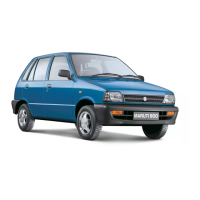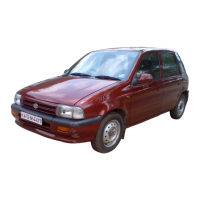Do you have a question about the MARUTI SUZUKI Tour S and is the answer not in the manual?
Information on vehicle keys, identification numbers, and immobilizer system for security.
Details on manual and central door locking systems for vehicle access.
Operation of the remote keyless entry transmitter for locking/unlocking doors.
Explanation of the vehicle's alarm mode and stages for unauthorized entry protection.
Instructions for manual and electric window controls, including auto-down feature.
Guidance on adjusting inside and outside rearview mirrors for optimal visibility.
Instructions for adjusting driver and front passenger seats and seatbacks for safety.
Guidance on proper seat belt usage and installation of child restraint systems.
Information on the vehicle's airbag system, components, and safety precautions.
Overview of gauges, indicators, and displays on the instrument cluster.
Explanation of various warning and indicator lights on the instrument panel and their meanings.
Operation of the lighting controls for headlights, position lights, and illumination.
Adjustment of headlight beam level according to vehicle load conditions.
Using turn signals for normal turns and lane changes.
Activating hazard warning lights for emergency signaling.
Operation of windshield wipers and the washer system.
Procedure for adjusting the steering wheel height using the tilt lock lever.
How to operate the vehicle's horn via the steering wheel button.
Precautions against exhaust gas hazards and carbon monoxide poisoning.
Routine checks for vehicle components before starting to drive.
Understanding normal engine oil consumption and factors influencing it.
Functions of ignition switch positions (LOCK, ACC, ON, START).
How to engage and disengage the parking brake lever.
Operation and function of clutch, brake, and accelerator pedals.
Procedures for starting the engine in various conditions.
Guidance on starting off and shifting gears smoothly.
Recommended maximum speeds for downshifting gears.
How the parking sensor system detects obstacles and alerts the driver.
Information on braking distance, power-assisted brakes, and ABS system.
Precautions for the initial 960 km of vehicle operation to ensure engine reliability.
Purpose and maintenance of the catalytic converter for emission control.
Tips and techniques to enhance vehicle fuel economy.
Importance of a clean air filter for engine performance and fuel efficiency.
Reducing vehicle load to improve fuel consumption.
Importance of correct tire pressure for fuel efficiency and safety.
Safe driving practices for highway conditions, including speed and wind effects.
Advice on driving uphill and downhill, including proper gear selection.
Precautions for driving on slippery surfaces like ice or wet roads.
Steps to free a vehicle stuck in difficult terrain and when to seek assistance.
Safe driving advice for wet conditions and avoiding engine damage.
Essential rules for safe driving, including posture, mirrors, and awareness.
Maintaining a safety margin to handle unexpected driving situations.
Opening, closing, and safe removal of the fuel filler cap.
Procedure for opening, supporting, and closing the engine hood.
Using sun visors to block glare from windshield and side windows.
Operation of the interior light switch for cabin illumination.
How to use the accessory socket for powering electrical devices.
Information on assist grips for passenger convenience.
Instructions for opening and closing the glove box.
Installation and use of front/rear frame hooks for emergency towing.
Overview of HVAC system, air outlets, and control descriptions.
Selecting fresh or recirculated air modes for HVAC.
Removing and reinstalling the car's radio antenna.
Vehicle weight capacities (GVWR, GAWR) and proper load distribution guidelines.
Warning against towing trailers due to vehicle design limitations.
Schedule for regular vehicle maintenance, including inspections and service intervals.
Inspecting and adjusting the engine drive belt for proper tension and condition.
Guidance on selecting engine oil, checking level, and replacing the oil filter.
Step-by-step process for draining engine oil and replacing the oil filter.
Selecting, checking, and adding engine coolant to maintain temperature.
Procedure for checking and replacing the air cleaner element.
How to access, inspect, and replace spark plugs for engine tuning.
Checking clutch pedal play for smooth gear shifting.
Checking brake fluid level in the reservoir.
Checking brake pedal height and distance to the floor.
Adjusting the parking brake for proper engagement and security.
Checking steering wheel play for smooth operation.
Checking tire pressure, tread depth, wear, and overall condition.
Rotating tires for even wear and prolonged lifespan.
Precautions for battery handling, checking electrolyte level, and terminal maintenance.
Identifying and locating fuses in the vehicle's fuse boxes.
Instructions for replacing various vehicle bulbs, with safety precautions.
Procedure for replacing headlight bulbs, including safety warnings.
How to inspect and replace windshield wiper blades for optimal performance.
Checking and refilling the windshield washer fluid reservoir.
Identification and location of tools for changing a flat tire.
Step-by-step guide on how to safely lift the vehicle with a jack.
Procedure for safely changing a vehicle wheel, including tightening nuts.
Safety precautions and steps for jump starting a vehicle.
Information on proper towing methods and precautions.
Troubleshooting steps if the vehicle starter fails to operate.
Procedure to start a flooded engine.
Steps to take if the engine overheats, including safe parking and checks.
How to deploy the warning triangle to alert traffic during breakdown.
Instructions for protecting the vehicle from corrosion through cleaning and repair.
Guidelines for cleaning the vehicle's interior and exterior.
Information on chassis and engine serial numbers for registration and service.
Details on the mandatory FASTag for electronic toll collection.
Requirements for High Security Registration Plates (HSRP) and their components.
Technical specifications for the vehicle's engine.
Electrical specifications, including spark plug and battery details.
Specifications for vehicle lights, including wattage and bulb numbers.
Specifications for tires, rims, and suspension components.
Approximate capacities for coolant, fuel tank, engine oil, and transmission oil.
| Brand | MARUTI SUZUKI |
|---|---|
| Model | Tour S |
| Category | Automobile |
| Language | English |











